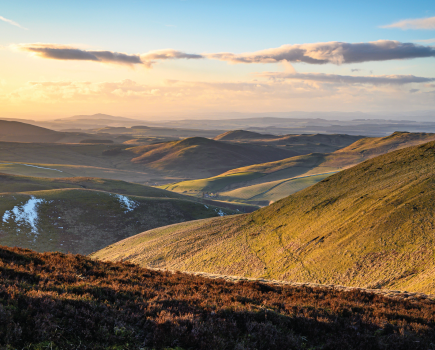
Andrew Galloway explores the Middlewood Way
In these days of high fuel prices, hectic lifestyles and, let’s be honest, unreliable summers, sometimes the lengthy drive from the cities and conurbations where most of us post-industrial Britons live and work, to the rural beauty and seclusion we love, is just too far, too expensive. Would that we all could hand in our notice, up-sticks and head off to a hafod of 50 sheep in Eifionydd, or a croft with a handful of belted Galloways in Sutherland. Of course, if we did, for sure two things would happen: one, we would all starve as a result of the greatest famine the British Isles had known, and two, we would destroy the very rural environment we love and cherish so much. No, sadly, in a country of 62 million people, most of us have to find a living in abstract occupations, returning only to our pastoral heritage at the weekend.
What a great idea then to allow part of our industrial heritage, the revolution that brought our ancestors in from the fields 150 years ago, to be partly reclaimed by nature, to give us urban dwellers a reservoir of recreational space without the costly, time-consuming and environmentally-damaging long-distance drive. For those of us who call the conurbation of Greater Manchester home, one such reservoir of rejuvenation is the Middlewood Way, a 16km/10 mile linear greenway reclaimed from the former Macclesfield, Bollington and Marple Railway, which closed in 1970. Running almost parallel with the Macclesfield Canal, and only a stone’s throw from the large National Trust estate of Lyme Park on the edge of the Peak District, the Way offers many opportunities for circular walks of varying length, or can be tackled as a linear route in its entirety, with public transport providing the link between Marple and Macclesfield.
There are many points of interest to break up the journey, including the nature reserve at Jacksons’ Brickworks, an area of reclaimed industrial landscape, which is particularly pleasant in spring and summer and attracts many species of birds and butterflies. At Nelson Pit there is a visitor centre run by Cheshire East Council, a pub, coffee house and the platforms of one of the former stations, which provide an interesting historical feature. The Way passes over Bollington by means of the most impressive feature of the route, the 23-arch sandstone viaduct that spans the River Dane, offering fabulous views across the town towards the Pennine hills. The viaduct was scheduled for demolition in the 1970s but a petition from the people of Bollington saved it as an historic landmark.
The route is popular with all types of people wanting to engage in many types of outdoor activities. In addition to walkers, there are runners, who take advantage of the potential for covering long distances without recourse to complicated maps or other navigational aids – on a former railway, you simply run one way, then return the other, counting the bridges as you go. Closer to the former mill towns of Bollington, Poynton and Marple, it is common to see families using the Way for cycling. There are many wheelchair-friendly access points, details of which can be obtained from the Cheshire East Council website. Even horse riding is permitted along the main section of the route, although riders are requested to limit their speed to walk and trot only.
Given the popularity of this suburban recreational facility on the edge of the third largest city in the United Kingdom, you can clearly see the benefit of handing back abandoned industrial landscape to nature.
ROUTE DESCRIPTION
- From Rose Hill Railway Station, Marple, turn left (west) along Stockport Road (A626) past The Railway pub, then turn left (south) onto Railway Road.
- After 100m the Middlewood Way begins, following the route of the old Marple to Macclesfield railway.
- Follow the well-marked Way to Macclesfield Station and then return by train via Manchester Piccadilly.
Andrew Galloway explores the Middlewood Way
In these days of high fuel prices, hectic lifestyles and, let’s be honest, unreliable summers, sometimes the lengthy drive from the cities and conurbations where most of us post-industrial Britons live and work, to the rural beauty and seclusion we love, is just too far, too expensive. Would that we all could hand in our notice, up-sticks and head off to a hafod of 50 sheep in Eifionydd, or a croft with a handful of belted Galloways in Sutherland. Of course, if we did, for sure two things would happen: one, we would all starve as a result of the greatest famine the British Isles had known, and two, we would destroy the very rural environment we love and cherish so much. No, sadly, in a country of 62 million people, most of us have to find a living in abstract occupations, returning only to our pastoral heritage at the weekend.
What a great idea then to allow part of our industrial heritage, the revolution that brought our ancestors in from the fields 150 years ago, to be partly reclaimed by nature, to give us urban dwellers a reservoir of recreational space without the costly, time-consuming and environmentally-damaging long-distance drive. For those of us who call the conurbation of Greater Manchester home, one such reservoir of rejuvenation is the Middlewood Way, a 16km/10 mile linear greenway reclaimed from the former Macclesfield, Bollington and Marple Railway, which closed in 1970. Running almost parallel with the Macclesfield Canal, and only a stone’s throw from the large National Trust estate of Lyme Park on the edge of the Peak District, the Way offers many opportunities for circular walks of varying length, or can be tackled as a linear route in its entirety, with public transport providing the link between Marple and Macclesfield.
There are many points of interest to break up the journey, including the nature reserve at Jacksons’ Brickworks, an area of reclaimed industrial landscape, which is particularly pleasant in spring and summer and attracts many species of birds and butterflies. At Nelson Pit there is a visitor centre run by Cheshire East Council, a pub, coffee house and the platforms of one of the former stations, which provide an interesting historical feature. The Way passes over Bollington by means of the most impressive feature of the route, the 23-arch sandstone viaduct that spans the River Dane, offering fabulous views across the town towards the Pennine hills. The viaduct was scheduled for demolition in the 1970s but a petition from the people of Bollington saved it as an historic landmark.
The route is popular with all types of people wanting to engage in many types of outdoor activities. In addition to walkers, there are runners, who take advantage of the potential for covering long distances without recourse to complicated maps or other navigational aids – on a former railway, you simply run one way, then return the other, counting the bridges as you go. Closer to the former mill towns of Bollington, Poynton and Marple, it is common to see families using the Way for cycling. There are many wheelchair-friendly access points, details of which can be obtained from the Cheshire East Council website. Even horse riding is permitted along the main section of the route, although riders are requested to limit their speed to walk and trot only.
Given the popularity of this suburban recreational facility on the edge of the third largest city in the United Kingdom, you can clearly see the benefit of handing back abandoned industrial landscape to nature.
ROUTE DESCRIPTION
- From Rose Hill Railway Station, Marple, turn left (west) along Stockport Road (A626) past The Railway pub, then turn left (south) onto Railway Road.
- After 100m the Middlewood Way begins, following the route of the old Marple to Macclesfield railway.
- Follow the well-marked Way to Macclesfield Station and then return by train via Manchester Piccadilly.








